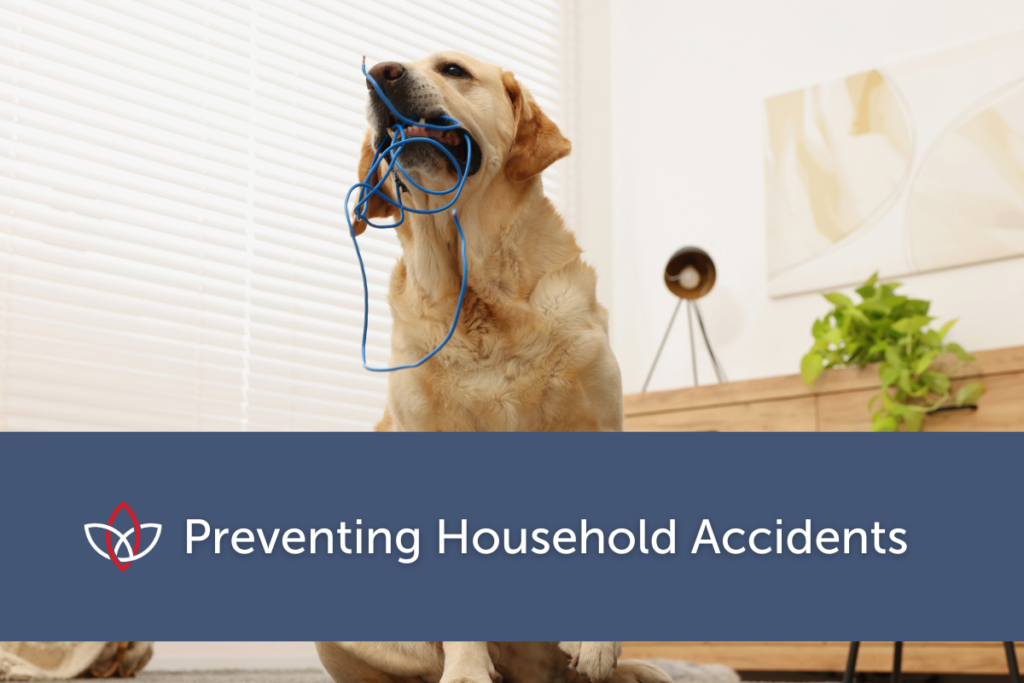
March is Pet Poison Prevention Awareness Month and safeguarding your home from toxic items is the first step in preventing your pet from an emergency vet clinic visit. Following are some pet safety tips to keep in mind not only this week, but year-round.
Keeping Harmful Substances Out of Reach
When we leave our pets home alone, we often leave the house thinking they’re safe. But there are many hidden dangers in our homes that curious pets like to get into. The most common hazards we hear about are chocolate, onions, grapes, and xylitol—a sugar substitute found in sugar-free gum, candy, and some hygiene products like toothpaste and mouthwash. Now, you may be thinking, my pet would never drink mouthwash, but you’d be surprised! When left to their own devices, pets can get bored and into more trouble than we think. Trouble that can lead to a visit at a 24-hour emergency vet clinic.
Common indoor and outdoor toxins for cats and dogs include…
- Antifreeze
- Mulch
- Fabric softener sheets
- Ice melting products
- Insecticides and pesticides
- Lawn fertilizers and weed killers
- Liquid potpourri
- Mothballs
- Paints and solvents
- Rat and mouse bait
- Various household cleaners, including bleach and toilet bowl cleaners)
- Swimming pool chemicals
- Salt dough Christmas tree ornaments and play dough
- Hygiene products, including mouthwash, toothpaste, make-up products, etc.
Some plants and flowers can also be harmful if your pet eats them. Here’s a common list that may be dangerous for your pet…
- Almond, apricot, cherry, nectarine, peach, and plum trees and shrubs
- Aloe Vera
- Amaryllis
- Caster Bean
- Chrysanthemum
- Cyclamen
- Corn Plant
- Daphne
- Dogbane
- English Ivy
- Foxglove
- Golden Pothos
- Hibiscus
- Hyacinth and Tulip (especially the bulbs)
- Hydrangea
- Kalanchoe
- Lilies: Daylily, Gloriosa Lily, Lily-of-the-Valley, Peace Lily, True Lily
- Mother-in-Law Tongue
- Mountain Laurel
- Narcissus, Daffodil, Paperwhite, and Jonquil
- Oleander
- Philodendron
- Poinsettia
- Rhododendron and Azalea
- Rosary Pea
- Sago Palm
- Schefflera
- Stinging Nettle
- Yesterday, Today and Tomorrow Plant
- Yew Bush
What to Do If Your Pet Ingests Something Harmful
If you know or suspect that your pet has gotten into something they shouldn’t have, here are some signs to watch out for:
Gastrointestinal Symptoms, including vomiting, diarrhea, lack of appetite, excessive drooling or foaming at the mouth.
Neurological Symptoms, including seizures/tremors, uncoordinated gate, dilated pupils, and anxiety.
Respiratory Difficulties, including difficulty breathing, coughing, and wheezing.
The best thing to do if you think your pet has ingested a toxic substance is to stay calm and seek immediate veterinary care. If your primary vet isn’t available, reach out to a 24-hour emergency vet clinic. Share as much information with them as you can, including what your pet might have ingested and how long they’ve been showing symptoms.
To learn more about how you can prepare for an emergency, read “Pet Emergencies: Are You Ready?”
Preventing Physical Injuries
Toxic substances aren’t the only hazard to your pets. Other pet safety tips include keeping heavy furniture secured, including bookcases and TV’s. These are often something we consider when there are small children in the house, but dogs with the zoomies and cats who like to climb on just about everything can get into some serious trouble if a heavy piece of furniture falls on them.
Do you have small objects like kid’s toys, socks, or crafting supplies around the house? If so, make sure those are secured in pet-proof containers. This also includes sharp objects and electrical cords. While you can’t put cords in a box, you can have them tucked away using a twist-tie or cover them with a protective tubing, which you can find in most home supply stores.
While these tips are especially important with young animals, even older pets can get curious about eating things they shouldn’t. When this happens, an intestinal blockage could occur leading to an emergency vet clinic visit.
Water and Drowning Hazards
Summer is right around the corner and with it comes swimming! Of course, some dogs are more excited about this than others, and as tempting as it is to let your pup swim to their heart’s content, there are important pet safety tips to remember before diving in, including…
- Don’t assume your dog is a strong swimmer
- Keep pool chemicals out of reach
- Consider buying a life jacket for your dog
- Keep plenty of fresh water available
- Use a fence to limit access
There are even indoor water precautions to keep in mind for dogs and cats, including unattended bathtubs filled with water and toilets.
Temperature Extremes
Finally, remember that our pets are sensitive to weather changes. Playing in the snow is fun, but extreme cold can cause hyperthermia and walking on salt-strewn sidewalks and roadways can cause sore feet. Soaring summer temps can also cause problems, including heat distress. Be sure to keep your pets out of hot cars and remember that their paws will burn on hot asphalt and concrete.
Be Proactive
We love our pets and the best thing we can do to keep them safe and away from an emergency vet clinic is to be proactive in preventing accidents. Keep their surroundings free of toxic substances (both food and non-food related), secure heavy furniture and items that can fall on them, and stay vigilant around water and in extreme temperatures.
Finally, keep emergency vet clinic contact info readily available. You can learn more about Partner’s Emergency services here and listen to our Did You Know? Podcast about how we care for our most critical patients.
Should you find yourself in a veterinary emergency, we can help!
Call our Frederick location at 301.200.8185
Call our Richmond location at 804.206.9122
